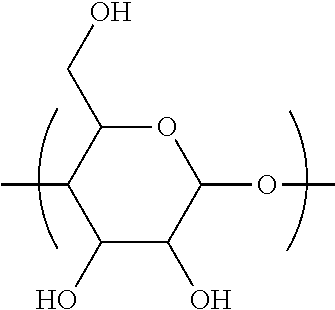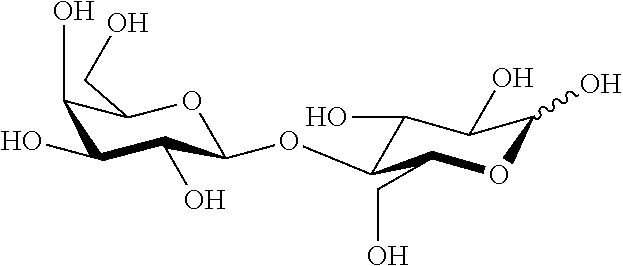Process for hydrotreating a hydrocarbon cut with a boiling point of more than 250°c in the presence of a sulphide catalyst prepared using a cyclic oligosaccharide
a technology of hydrotreating process and hydrocarbon feed, which is applied in the direction of catalyst regeneration/reactivation, hydrocarbon oil treatment products, physical/chemical process catalysts, etc., can solve the problems of increasing the catalytic activity of metals, and increasing the difficulty of hydrotreating cuts. , to achieve the effect of improving catalytic performan
- Summary
- Abstract
- Description
- Claims
- Application Information
AI Technical Summary
Benefits of technology
Problems solved by technology
Method used
Image
Examples
example 2 (
In Accordance with the Invention)
Preparation of Catalysts C1′, C2′, C3′, C4′
[0088]Catalysts C1′, C2′, C3′ and C4′ were prepared in accordance with said step i1) followed by a step for drying ii) and a step for calcining iii) in accordance with the process of the invention.
[0089]Catalyst C1′ was obtained by dry impregnation of said dried pre-catalyst C1 using an aqueous solution containing β-cyclodextrin (SIGMA-ALDRICH, 98% pure) in a molar ratio (Co+Mo) / β-cyclodextrin of 30, with a volume rigorously equal to the pore volume of the pre-catalyst C1. After the dry impregnation step, the extrudates were allowed to mature in a water-saturated atmosphere for 12 h then were dried overnight at 100° C. and calcined at 450° C. for 2 hours to obtain the catalyst C1′ in accordance with the invention.
[0090]C2′ was obtained from the pre-catalyst C2 using the same process.
[0091]C3′ was obtained from the pre-catalyst C3 using the same process.
[0092]C4′ was obtained from the pre-catalyst C4 using th...
example 3 (
In Accordance with the Invention)
Preparation of Catalyst C1″(Co-Impregnation)
[0094]Catalyst C1″ was prepared in accordance with said step i2) followed by a drying step ii) and by a step for calcining iii) in accordance with the process of the invention.
[0095]The solution to carry out the co-impregnation was prepared by dissolving molybdenum oxide (24.34 g) and cobalt hydroxide (5.34 g) in a hot solution of phosphoric acid (7.47 g) in aqueous solution. After cooling to ambient temperature, β-cyclodextrin (SIGMA-ALDRICH, 98% pure) was added to the solution in a (Co+Mo) / β-cyclodextrin ratio of 30. The co-impregnation solution was thus obtained.
[0096]Catalyst C1″ was obtained by dry impregnation of a gamma alumina support in the form of extrudates, prepared in accordance with Example 1, using the co-impregnation solution with a volume rigorously equal to the pore volume of the mass of said support. After the dry impregnation step, the extrudates were allowed to mature in a water-saturat...
example 6
Catalytic Performances of Pre-Catalysts C1, C2, C3 and C4 and of Catalysts C1′, C2′, C3′, C4′, C1″, C5, C6 and C7 in Model Molecule Tests for Thiophene HDS
[0104]A model feed containing 10% by weight of 2,3-dimethylbut-2-ene and 0.33% by weight of 3-methylthiophene (i.e. 0.1% by weight of sulphur in the feed) was used to evaluate the catalytic performances of the various catalysts. The solvent used was heptane.
[0105]Catalysts C1, C2, C3 and C4 and catalysts C1′, C2′, C3′, C4′, C1″, C5, C6 and C7 had already been sulphurized ex situ in the gas phase at 450° C. for 2 hours in a stream of H2S in hydrogen (15% by volume of H2S in H2).
[0106]The hydrodesulphurization reaction was carried out in a closed Grignard type reactor under 3.5 MPa of hydrogen pressure, at 250° C. Each of the pre-catalysts C1, C2, C3 and C4 and catalysts C1′, C2′, C3′, C4′, C1″, C5, C6 and C7 were placed in succession in said reactor. The effluents were sampled at different time intervals and analyzed by gas chromat...
PUM
| Property | Measurement | Unit |
|---|---|---|
| Temperature | aaaaa | aaaaa |
| Temperature | aaaaa | aaaaa |
| Fraction | aaaaa | aaaaa |
Abstract
Description
Claims
Application Information
 Login to View More
Login to View More - R&D
- Intellectual Property
- Life Sciences
- Materials
- Tech Scout
- Unparalleled Data Quality
- Higher Quality Content
- 60% Fewer Hallucinations
Browse by: Latest US Patents, China's latest patents, Technical Efficacy Thesaurus, Application Domain, Technology Topic, Popular Technical Reports.
© 2025 PatSnap. All rights reserved.Legal|Privacy policy|Modern Slavery Act Transparency Statement|Sitemap|About US| Contact US: help@patsnap.com



